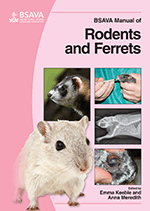
Full text loading...

Incorrect positioning of small mammal patients such as ferrets has been quoted as the most common reason for non-diagnostic radiographs or misdiagnosis of disease. In the majority of cases it is preferable to ensure that the patient is immobilized chemically when performing radiography, either through gaseous or injectable sedation or anaesthesia. This will allow the correct anatomical positioning of the patient for standard comparable views to be taken and ensure that clinicians and support staff can vacate the immediate area, complying with any ionizing radiation Health and Safety regulations. Ferrets also tend to be uncooperative when physically restrained, therefore chemical restraint is recommended for their safety and that of the operators. This chapter looks at Positioning; Equipment; and Interpretation of radiography and ultrasonography.
Ferrets: diagnostic imaging, Page 1 of 1
< Previous page | Next page > /docserver/preview/fulltext/10.22233/9781905319565/9781905319565.19-1.gif

Full text loading...













